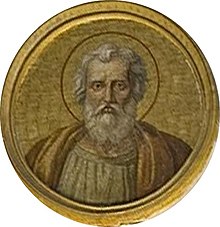Felix II (antipope)

Felix II († November 22nd, 365 in Portus Romae ) was bishop of Rome from 355 to 358 , i.e. pope or antipope of the Roman Catholic Church and is sometimes viewed as a martyr and saint. He is generally considered an antipope rather than a pope.
In order to take into account the different views on this issue, the rightful Pope Felix II is therefore often noted as "Felix II (III.)". Likewise, in the naming of Pope Felix III. procedure: “Pope Felix III. (IV.) ". In the case of the contrary opinion, “Felix III. (II.) ”Or for the later official of the same name:“ Pope Felix IV. (III.) ”. It is therefore important to pay attention to the lower number in order to get the numbering of the official name Felix practiced by the Catholic Church .
Life
The time was marked by disputes about the believers in the Christian belief system of Arianism , which apparently could win strong support in the circles of secular rulers, while numerous church leaders were rather negative. When Pope Liberius was banished by Emperor Constantius II because he did not want to support the emperor's judgment on the banishment of Athanasius , Felix II was summoned pope by the archdeacon in Rome in 356 . He therefore went down in history as one of the anti-popes.
His election was carried out against the wishes of both the clergy and the people. Prelates belonging to the court performed the coronation ceremony . However, while the clergy soon joined Felix, the people continued to reject him.
In 357 Constantius agreed to the urgent requests of influential Roman ladies to bring Liberius out of exile. Constantius issued an edict that both bishops had equal rights to rule together, but Liberius was received so enthusiastically by all classes on his arrival in Rome that Felix was forced to leave Rome immediately.
Little is known about the rest of his life and the evidence about it is contradicting. He probably spent most of the rest of his life on his estates near Portus Romae . He died there on November 22nd, 365. His relics are in the church of Santa Maria Immacolata in Ceri (Cerveteri) , which was also consecrated to him until the 19th century.
Felix II was added to the list of martyrs , but nobody knows why. He may have been mistaken for an African martyr named Felix. During the time of Gregory XIII. the admission of Felix to the rank of ordinary popes was discussed. To answer the question, his body was exhumed to find traces of miracle work. It is said that the words pope and martyr were found on his body, but this supernatural evidence contradicts the older sources of the church, which is why Felix II is not regularly considered as pope in today's times. His veneration as a saint is also attributed to a mix-up with an African martyr bishop Felix.
His holiday is July 29th .
literature
- Adolf Jülicher : Felix 19 . In: Paulys Realencyclopadie der classischen Antiquity Science (RE). Volume VI, 2, Stuttgart 1909, Col. 2168 f.
- Entry in the Catholic Encyclopedia , Robert Appleton Company, New York 1913.
- Harald Zimmermann : Felix II. In: Lexicon of the Middle Ages (LexMA). Volume 4, Artemis & Winkler, Munich / Zurich 1989, ISBN 3-7608-8904-2 , column 140.
- Friedrich Wilhelm Bautz : Felix II. In: Biographisch-Bibliographisches Kirchenlexikon (BBKL). Volume 2, Bautz, Hamm 1990, ISBN 3-88309-032-8 , Sp. 9-10.
- Georg Schwaiger : Felix (II.) . In: Walter Kasper (Ed.): Lexicon for Theology and Church . 3. Edition. tape 3 . Herder, Freiburg im Breisgau 1995, Sp. 1218 .
- Christiane Laudage: Fight for the chair of Petri. The history of the anti-popes. Herder, Freiburg im Breisgau 2012, ISBN 978-3-451-30402-6 , p. 38 f.
| personal data | |
|---|---|
| SURNAME | Felix II |
| BRIEF DESCRIPTION | Pope or Antipope (355–358) |
| DATE OF BIRTH | 3rd century or 4th century |
| DATE OF DEATH | November 22, 365 |
| Place of death | Portus Romae |